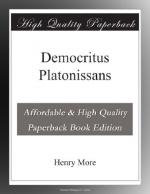|
This section contains 390 words (approx. 2 pages at 300 words per page) |
World of Mathematics on Democritus of Abdera
Democritus of Abdera is best known for his atomic theory of the universe, but also made significant contributions to the study of geometry. Not much is known of his life, but rather extensive knowledge remains about his philosophies. He wrote a large amount of works on a variety of subjects including ethics, language, literature, logic, mathematics, music, and physics. Some of the titles relevant to mathematics are: On Numbers, On Geometry, On Tangencies, On Mappings, and On Irrationals.
Born to a wealthy family in Abdera (Avdhira, Greece), an ancient port on the coast of Thrace, Democritus used his inheritance for the sole purpose of acquiring knowledge. He traveled extensively (by ancient standards) and visited Egypt, Ethiopia, Persia, and India. He may have even visited Athens to study under Anaxagoras of Clazomenae (499-428 B.C.), the great mathematician and philosopher.
The foundation for all of Democritus' mathematics was based upon the theory of Atomism. An elaboration of his mentor Leucippus' theory (c. 480-420 B.C.), Atomism explains that the universe is composed of a void, or vacuum, and an infinite number of atoms. These atoms are atomon (the Greek word for indivisible), impassable (completely filling the space they occupy), and eternal. Although each is indivisible, they possess the ability to link with others to form larger objects--the visible entities of reality. And through variations in the shapes and arrangement of these atoms, coupled with the degree of void within the substance, individual objects are created. From this concept, Democritus could explain all facets of everything in existence within the physical world. For example, Democritus claimed that the atoms of iron and water were identical. Their inherent differences come from the fact that water atoms are glossy spheres that are unable to hook onto one another. Thus, the water atoms continually roll over one another creating a liquid form. On the other hand, the atoms of iron are jagged and rough, and therefore cling together to form a solid mass.
Since all things were predicated upon the theory of Atomism, Democritus' mathematics focused primarily on infinitesimal problems and the concept of the geometrical atom. For example, Democritus had the idea of a solid being the sum of many parallel planes, and he may have used this concept while calculating the line segment, area, or volume of a cone and pyramid.
|
This section contains 390 words (approx. 2 pages at 300 words per page) |


